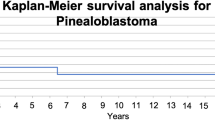Abstract
Introduction Pineoblastomas are a category of supratentorial primitive neuroectodermal tumors (sPNETs) occurring in the pineal gland; some studies support the impression that patients with pineoblastomas have a worse prognosis than those with other sPNETs. Methods We reviewed the medical records and tissue sections of all patients with the diagnosis of pineoblastoma that were treated at the Dana-Farber Cancer Institute/Children’s Hospital Boston Pediatric Brain Tumor Program between 1986 and 2005. Results Thirteen patients with the pathologic diagnosis of pineoblastoma were treated at our Hospital; 11 of these cases had complete records suitable for study. The median age was 8 years 8 months (5 F, 6 M). Surgical, radiation and chemotherapeutic regimens varied from case to case. Three patients had gross total resection and are alive and free of disease, versus four of eight with subtotal resection or biopsy only. Patients who received CSI and multi-agent chemotherapy had improved overall survival. Conclusions Seven of eleven patients with pineoblastoma are currently alive and free of disease, reflecting an improved outcome and longer survival than previously appreciated. Gross total surgical resection appeared to correlate with improved survival, as did treatment with craniospinal irradiation and multi-agent chemotherapy. Further study of this group of patients as a distinct diagnostic entity will be necessary to determine optimal therapy.

Similar content being viewed by others
References
Ullrich N, Pomeroy S (2003) Pediatric brain tumors. Neurol Clin 21:897–913
Reddy A et al (2000) Outcome for children with supratentorial primitive neuroectodermal tumors treated with surgery, radiation, and chemotherapy. Cancer 88(9):2189–2193
Gururangan S et al (2003) High-dose chemotherapy with autologous stem-cell rescue in children and adults with newly diagnosed pineoblastomas. J Clin Oncol 21(11):2187–2191
Jakacki R (1999) Pineal and nonpineal supratentorial primitive neuroectodermal tumors. Childs Nerv Syst 15:586–591
Li M et al (2005) Molecular genetics of supratentorial primitive neuroectodermal tumors and pineoblastoma. Neurosurg Focus 19(5):1–17
Jakacki R et al (1995) Survival and prognostic factors following radiation and/or chemotherapy for primitive neuroectodermal tumors of the pineal region in infants and children: a report of the childrens cancer group. J Clin Oncol 13(6):1377–1383
Cohen B et al (1995) Prognostic factors and treatment results for supratentorial primitive neuroectodermal tumors in children using radiation and chemotherapy: a children’s cancer group randomized trial. J Clin Oncol 13(7):1687–1696
Louis D et al (2007) WHO classification of tumors of the central nervous system. International Agency for Research on Cancer, Lyon
Judkins A et al (2004) Immunohistochemical analysis of hSNF5/INI1 in pediatric CNS neoplasms. Am J Surg Pathol 28(5):644–650
Judkins A et al (2005) INI protein expression ditinguishes atypical teratoid/rhabdoid tumor from chorioid plexus carcinoma. J Neuropathol Exp Neurol 64(5):391–397
Cuccia V et al (2006) Pineoblastomas in children. Childs Nerv Syst 22:577–585
Hinkes B et al (2006) Childhood pineoblastoma: experiences from the prospective multicenter trials HIT-SKK87, HIT-SKK92 and HIT91. J Neurooncol 81(2):217–223
Gururangan S et al (2003) High-dose chemotherapy with autologous stem-cell rescue in children and adults with newly diagnosed pineoblastomas. J Clin Oncol 21(11):2187–2191
Lamont J et al (2004) Combined histopathological and molecular cytogenetic stratification of medulloblastoma patients. Clin Cancer Res 10:5482–5493
Fernandez-Teijeiro A et al (2004) Combining gene expression profiles and clinical parameters for risk stratification in medulloblastomas. J Clin Oncol 22(6):994–998
Gajjar A et al (2004) Clinical, histopathologic, and molecular markers of prognosis: toward a new disease risk stratification system for medulloblastoma. J Clin Oncol 22(6):984–993
Eberhart C et al (2002) Histopathologic grading of medulloblastomas—a pediatric oncology group study. Cancer 94(2):552–560
Giangaspero F et al (2006) Stratification of medulloblastoma on the basis of histopathological grading. Acta Neuropathol 112:5–12
Brown A et al (2006) Cytogenetics of pineoblastoma: four new cases and a literature review. Cancer Genet Cytogenet 170:175–179
Saran F et al (1998) Survival of very young children with medulloblastoma (primitive neuroectodermal tumor of the posterior fossa) treated with craniospinal irradiation. Int J Radiat Oncol Biol Phys 42(5):959–967
Geyer J et al (2005) Multiagent chemotherapy and deferred radiotherapy in infants with malignant brain tumors: a report from the children’s cancer group. J Clin Oncol 23(30):7621–7631
Duffner P et al (1995) Lack of efficacy of postoperative chemotherapy and delayed radiation in very young children with pineoblastoma. Pediatric oncology group. Med Pediatr Oncol 25(1):38–44
Duffner P et al (1999) The treatment of malignant brain tumors in infants and very young children: an update of the pediatric oncology group experience. Neuro-oncology 4:152–161
Kellie S et al (2002) Activity of postoperative carboplatin, etoposide, and high-dose methotrexate in pediatric CNS embryonal tumors: results of a phase II study in newly diagnosed children. Med Pediatr Oncol 93:168–174
Bronsicer A et al (2004) High-dose chemotherapy with autologous stem-cell rescue in the treatment of patients with recurrent non-cerebellar primitive neuroectodermal tumors. Pediatr Blood Cancer 42:261–267
Graham M et al (1997) High-dose chemotherapy with autologous stem-cell rescue in patients with recurrent and high-risk pediatric brain tumors. J Clin Oncol 15(5):1814–1823
Author information
Authors and Affiliations
Corresponding author
Rights and permissions
About this article
Cite this article
Gilheeney, S.W., Saad, A., Chi, S. et al. Outcome of pediatric pineoblastoma after surgery, radiation and chemotherapy. J Neurooncol 89, 89–95 (2008). https://doi.org/10.1007/s11060-008-9589-2
Received:
Accepted:
Published:
Issue Date:
DOI: https://doi.org/10.1007/s11060-008-9589-2




